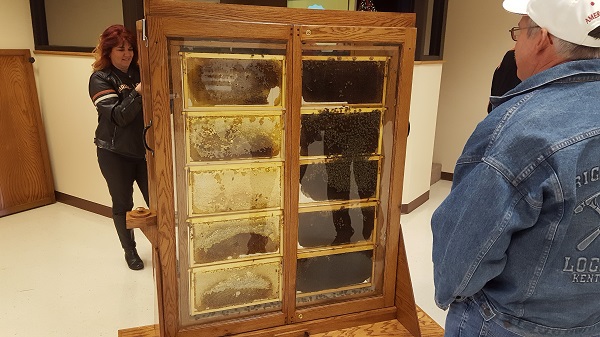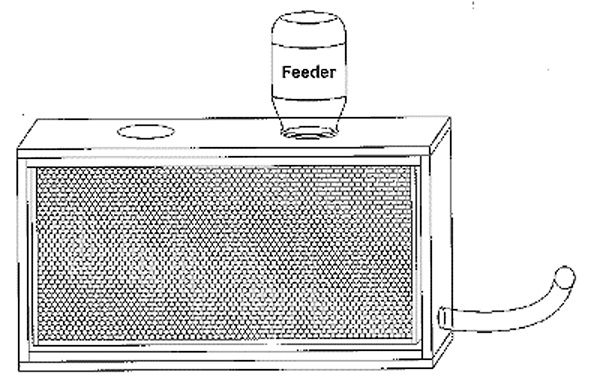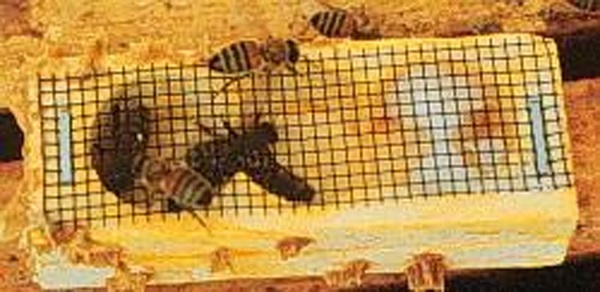Starting An Observation Hive of Honey Bees
ENTFACT-700: Starting An Observation Hive of Honey Bees | Download PDF
by Ric Bessin, Extension Entomologist
University of Kentucky College of Agriculture
Certainly the best method to learn about honey bees is through the use of a glass observation hive. It is equipped with glass on both sides so that the queen and all activities of the bees may be observed at all times.
Honey bees are truly amazing creatures to watch, and an observation hive allows you to see day-to-day activities within the hive without disrupting or irritating the bees.

Figure 1. Observation hives can be very elaborate.
With an observation hive you can:
- Study honey bee colony structure and organization,
- See different honey bee castes and their duties within the hive,
- Follow the development of honey bee larvae,
- Watch comb building, honey production and storage,
- Observe their communication with the bee dance.
Observation hives are ideally suited for 4-H and science projects, class room studies, nature displays, or just as a leisure time activity at home.
Getting the Equipment
While it is not difficult to construct the hive at home, it is very important to have a good understanding of standard hive dimensions and "bee space". If the spacing is not correct, the bees will fill in wide gaps with additional comb or they may seal off areas that are too narrow. There are commercially available kits which can be put together in about an hour.
Sources of these kits, package bees, and queens include:
- Dadant and Sons, Hamilton, IL, (217) 847-3324
- Walter T. Kelley Co, Clarkson, KY, (502) 242-2012
- Brushy Mountain Bee Farm, Moravian Falls, NC, (800) 233-7929
- A. I. Root Co., Medina, OH, (800) 289-7668
Most kits need to be assembled and are usually shipped without the glass. Double strength glass of the correct dimensions will need to be obtained locally. Several different types of designs are available, some allow for expansion of the observation hive as the number of bees increase, others are fixed in size. You will need to feed the bees quite a bit of sugar syrup, so the hive must be equipped with a method to feed the colony.
Getting Bees into the Hive
There are three methods of obtaining bees for your observation hive; 1) capturing a small swarm, 2) buying a half pound of bees (the standard size sold for observation hives), or 3) splitting off a portion of a larger established hive.

Figure 2. A very basic observation hive.
A reliable strain of bees can be obtained from a professional bee-breeder. The companies that supply package bees will usually also sell packages suitable for observation hives. Because the season for shipping bees is short and the supply is limited, book your order in winter for spring delivery. Companies that sell observation hives and bees will supply directions for hiving the bees.
Bees can also be obtained by dividing an established colony. When doing this, it is important to keep the old queen in the original hive. A new queen will need to be purchased for the observation hive. Begin by selecting one or two frames from an established colony. These frames should be straight and narrow (no bulges in the side), well populated with bees, contain a mixture of honey and honey bee brood, and not have the queen. Close the entrance and place these frames into the observation hive; work slowly and be careful not to crush the attached bees. Close the top of the observation hive and move it to its new location, preferably at least two miles from the old colony. Once it is in place, open the entrance for the bees. The next day, insert the cage with the new queen into the hive.
Remove the pasteboard over the candy end of the queen cage and use a small nail to punch a small hole through the candy. Do not make the hole so large that the queen can get out immediately.

Figure 3. Inspect the queen in her cage when she arrives.
Check to see if the queen is all right. She is slightly larger than the attendant workers. Push the cage into the hive through the entrance. If the queen has not escaped from her cage after seven days, let her out.
Swarms may be discovered under a variety of circumstances so there is no single procedure to capture and hive them. You can anticipate the swarming season and be ready on short notice with equipment to deal with the situation. After a swarm issues from a hive it may settle on a nearby tree, fence post, side of a building, or other similar object. If the clustering is within two or three feet of the ground, it is relatively easy to capture the swarm. The hive is placed on a sheet of canvas adjacent to the cluster of bees. A smoker can be used to gently drive the bees toward the entrance of the hive, but the bees will usually enter the hive without encouragement. Brushing may have to be done two or three times to get the majority of the bees in the hive. As soon as the bees are in the hive, seal the entrance and move it to its new location. Open the hive once it is at the new location.
Selecting a Location for the Observation Hive
An observation hive may be kept year round indoors. It can be located just about anywhere, but there are a few precautions to consider. The hive entrance should be located away from walkways, paths or other high traffic areas to avoid conflict. Most importantly, the hive should be located in a room where it is easily visible. The hive should not be in direct sunlight. The glass hive acts like a greenhouse and sunlight striking the hive will cause it to heat quickly which may kill the bees and cause the wax to melt.
The hive should be mounted on a secure object so that it will not be knocked over or disturbed. In classrooms it may be advisable to screw it to a counter or window sill.
The plastic tube used by the bees to come and go generally should be level, less than three feet in length, and be mounted flush on both the hive and outdoors ends. A lip of 1/2 inch or more causes the bees to be confused and not use the entrance properly.
Feeding the Colony
As soon as the bees are in the hive and the hive is secure, you will need to begin regularly feeding the colony sugar syrup. Make the syrup by mixing 1 part sugar to 1 part hot water. Cool the mixture before feeding it to the bees. Continue to feed the bees until nectar begins to flow and the colony is strong enough to begin storing honey.
Letting the Colony Expand
In the spring, it usually does not take long before the number of bees in the colony begins to increase rapidly. Soon the hive becomes packed with honey bees. While this is an indication of a strong colony, there are some distinct disadvantages. With so many bees within the hive, it may become difficult to see much more than just a mass of bees underneath the glass. Also, as the colony becomes overcrowded, the bees are more likely to swarm. Often when a colony in an observation hive swarms, it may lose 60 to 70 % of the bees as well as the old queen. The remaining bees will raise a new queen, but it may be many weeks before the colony recovers in strength.
As the colony begins to become overcrowded, it is time to expand the hive. Some commercially built observation hives are expandable, the top can be removed and an additional observation super added to the hive. It is easiest to add the super outdoors. Close the entrance to the hive and plug the hole through which the bees enter the building. Take the hive outside the building near their entrance to add the super. Before opening the hive, calm the bees with small amount of smoke. Open the hive, place the new super on top, and close the hive. Use screws to hold the hive and super together. After the new super is secure, take the hive back indoors, open the entrance and reattach the tube.
While you can continue to add supers as needed in this manner, additional support may be required to keep the hive from toppling over. In the late fall and winter, if bees recede and desert a super, the super can be removed.
Revised: 8/22
CAUTION! Pesticide recommendations in this publication are registered for use in Kentucky, USA ONLY! The use of some products may not be legal in your state or country. Please check with your local county agent or regulatory official before using any pesticide mentioned in this publication.
Of course, ALWAYS READ AND FOLLOW LABEL DIRECTIONS FOR SAFE USE OF ANY PESTICIDE!
Images: University of Kentucky Entomology
